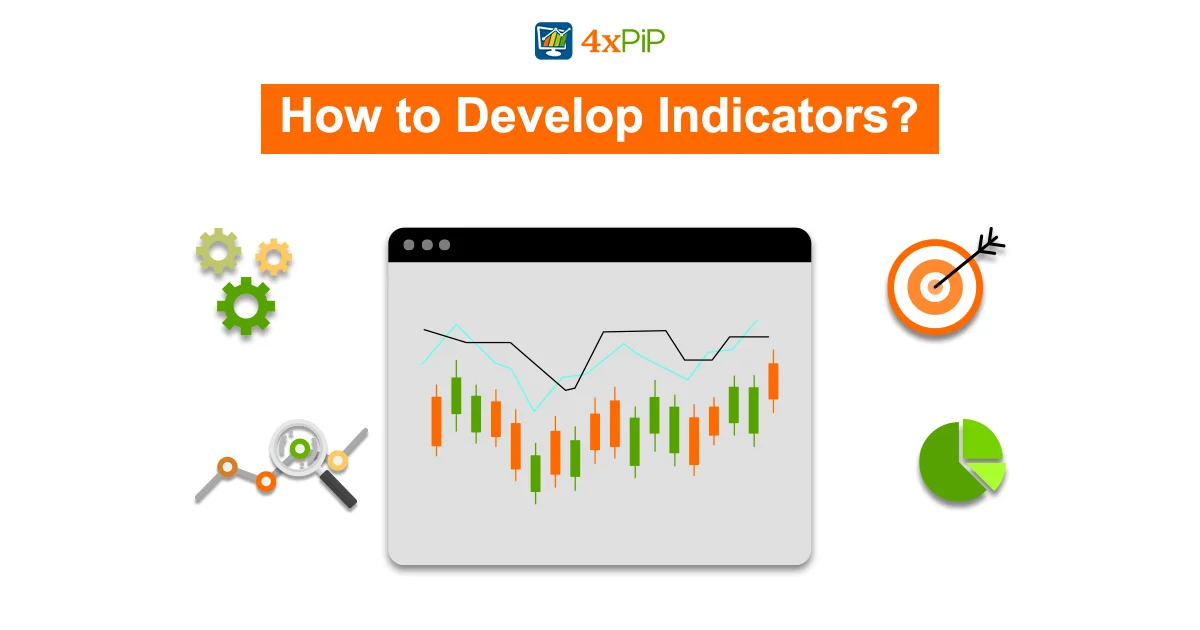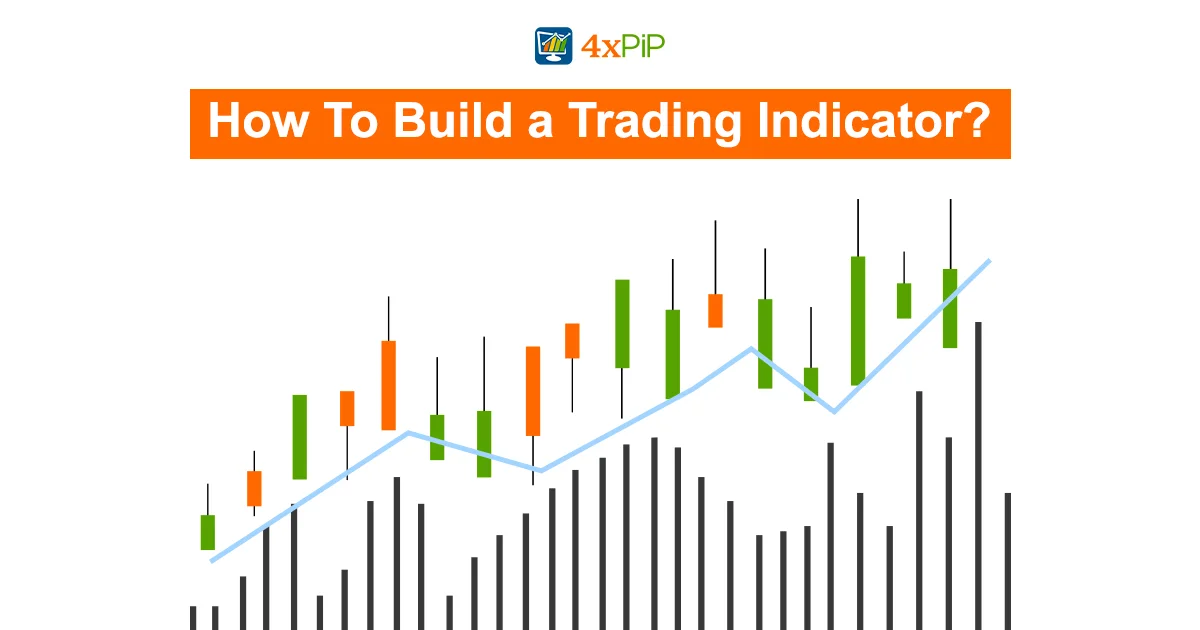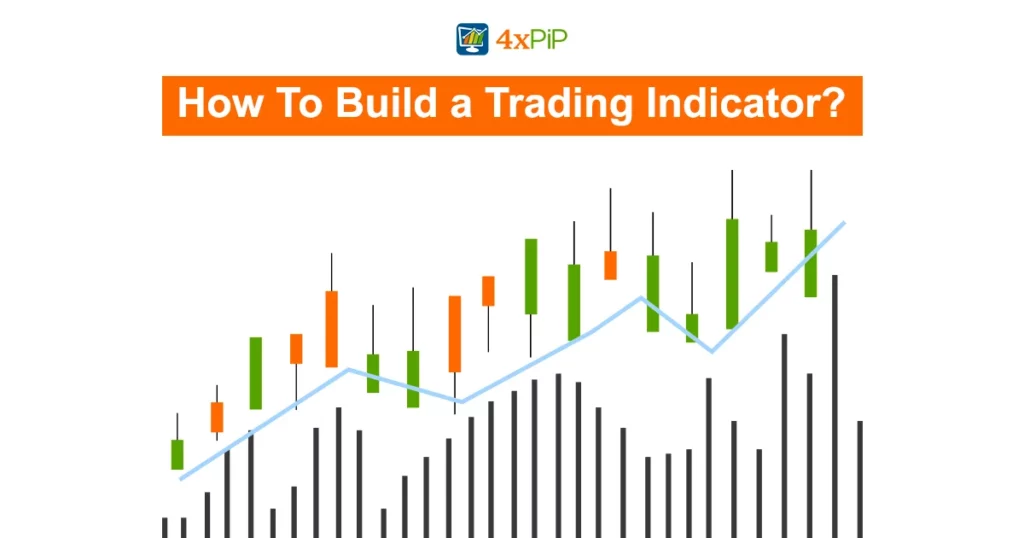Are you a trader looking to gain an edge in stocks, cryptocurrency, and forex? Building your trading indicator is a powerful strategy for informed decision-making. In this guide, we simplify the process, ensuring you grasp the essentials without complex jargon. Understand what indicators are, choose the right platform, align with your strategy, back-test for accuracy, and explore unique and hybrid indicators. We even walk you through creating Bollinger Bands, a popular indicator. Also, you can explore advanced customization strategies and resources on our website for a significant trading edge. In this article, 4xPip is here to guide you through the process in simple terms.
How to Build A Trading Indicator?

Understanding the Basics:
Before we dive into the technical details, it’s essential to grasp what a trading indicator is. A trading indicator is a mathematical calculation applied to the price, volume, or open interest of an asset, such as stocks, cryptocurrency, or forex. Also, it provides valuable insights into market trends, helping you to spot potential buy or sell opportunities.
Choose Your Platform
For traders, platforms like MetaTrader 4 (MT4) and MetaTrader 5 (MT5) offer excellent support for building custom indicators. You can access these platforms on 4xPip’s website, where you’ll find a wealth of resources and tools. Moreover, they provide MetaTrader Expert Advisors (EAs) and indicators to enhance your trading experience.
Learn the Programming Language
To create your trading indicator, you’ll need to learn the programming language specific to your trading platform, such as MQL4 for MT4 and MQL5 for MT5. However, this may sound intimidating, but 4xPip’s experts can provide guidance and even offer pre-built indicators if you’re not comfortable with coding.
Define Your Strategy:
Your trading indicator should align with your trading strategy. Whether you’re a day trader, swing trader, or a long-term investor, 4xPip offers solutions for all types of traders. Furthermore, their indicators and EAs can be tailored to your specific approach.
Backtest and Refine
Once your trading indicator is coded, it’s crucial to backtest it to see how it would have performed in the past. This helps you refine the indicator and improve its accuracy. Also, 4xPip’s website offers a range of backtesting tools and services to assist you in this process.
Generating Unique Indicators:
When delving into the world of trading, whether in the stock market, cryptocurrency, or forex, understanding the tools at your disposal is essential. In this article, we will explore the components of unique indicators that can help traders make informed decisions. These indicators, available on platforms like MetaTrader 4 (MT4) and MetaTrader 5 (MT5), play a crucial role in the day-to-day activities of investors and traders.
Moreover, indicators are essentially tools that help traders analyze price movements and market trends. They come in various forms, catering to different trading styles such as day trading and swing trading. Some traders prefer the fast-paced world of day trading, where they buy and sell assets within the same day, while others adopt a more patient approach with swing trading, holding onto assets for a longer period.
Furthermore, to effectively use these indicators, traders often turn to Expert Advisors (EAs) or auto-trading robots to automate their strategies. These EAs can be programmed to follow specific trading rules and execute trades on behalf of the trader, saving time and reducing the emotional stress associated with manual trading.
Additionally, indicators and EAs can be customized, allowing traders to tailor their trading strategies to their unique preferences. By using platforms like MetaTrader 4 (MT4) and MetaTrader 5 (MT5), traders can access a wide range of pre-built indicators or create their own using MQL4 or MQL5 programming languages.
An Introduction to Hybrid Indicators:
Trading in the stock market, whether it’s day trading or swing trading, requires the use of various tools and strategies to make informed decisions. One essential tool that traders often rely on is indicators. Indicators are like guiding stars in the trading world, helping traders analyze market trends and make well-informed decisions. In this article, we’ll delve into the components of hybrid indicators and how they can benefit both novice and experienced traders.
Furthermore, hybrid indicators, in essence, are trading tools that combine elements from different types of indicators to provide a more comprehensive view of the market. These indicators are a blend of technical indicators, moving averages, and sometimes even fundamental data. This fusion of different aspects of analysis enables traders to make better predictions and reduce risks.
Moreover, one of the key benefits of hybrid indicators is their versatility. They can be used in various financial markets, such as stocks, cryptocurrencies, and forex. Traders who are into forex trading often find hybrid indicators particularly useful, as they can be applied in popular platforms like MetaTrader (MT4 and MT5).
Additionally, the components of hybrid indicators typically include a combination of price-based indicators like the Relative Strength Index (RSI), Moving Average Convergence Divergence (MACD), and Stochastic Oscillator. Furthermore, they may incorporate other factors, such as trading volume and market sentiment, to provide a more holistic view of the market.
Traders often use hybrid indicators to identify entry and exit points, assess market trends, and gauge the strength of price movements. Consequently, these indicators are a valuable tool for day traders and swing traders alike. However, it’s important to note that while hybrid indicators can be incredibly helpful, they should be used in conjunction with other analysis methods and risk mitigation strategies.
How to Develop Indicators?
Are you a budding trader eager to dive into the world of trading? One crucial aspect of trading is creating your own indicator, a tool that can help you make more informed decisions in the market. In this article, we’ll guide you through the process of creating a trading indicator step by step, without diving into overly complex jargon.

- Start with a Clear Objective:
Before you begin, it’s essential to have a clear objective for your indicator. Decide what specific market conditions or trends you want to identify. This clarity will help you design an effective indicator.
- Choose the Right Platform:
You can create trading indicators on various platforms, such as MetaTrader 4 (MT4) or MetaTrader 5 (MT5). These platforms are user-friendly and widely used by traders worldwide. Pick the one that suits your needs.
- Study and Understand Market Data:
To create an indicator, you need to understand the data you’re working with. This includes knowledge of price movements, volumes, and different time frames. A thorough understanding of market data is vital for crafting a useful indicator.
- Define the Indicator Formula:
Now comes the core of the process. Define the formula that will be the basis for your indicator. For example, if you’re creating a moving average indicator, the formula would involve averaging the closing prices over a specified period.
- Test and Fine-Tune:
Once you have the initial formula, it’s crucial to test your indicator on historical data. This step helps you understand how your indicator would have performed in the past and whether it’s effective. Be prepared to fine-tune the formula based on the results.
- Set Alerts and Parameters:
Most trading platforms allow you to set alerts and parameters for your indicators. These alerts can help you stay updated on market conditions and make timely decisions. Customize these settings as needed.
- Keep Learning and Improving:
Creating an indicator is not a one-time process. The market evolves, and so should your indicator. Stay updated with market trends, and continuously work on improving your indicator to adapt to changing conditions.
Advanced Strategies for Customizing Your Trading Indicators:
Certainly, let’s continue with a topic related to building a technical indicator:
In our previous section, we discussed how to create your own trading indicator. Now, let’s take it a step further and explore advanced strategies for customizing these indicators. Building a basic indicator is just the beginning; tailoring it to your unique trading style and preferences can significantly improve your trading success.
- Indicator Parameters and Settings:
Customizing your indicator’s parameters and settings is key to aligning it with your trading strategy. By fine-tuning these settings, you can make your indicator more responsive or conservative, depending on your risk tolerance and goals.
-
Combining Indicators:
Many experienced traders use multiple indicators to cross-verify signals. Learn how to combine different indicators to enhance the accuracy of your trading decisions. For example, you can use Bollinger Bands in conjunction with the Relative Strength Index (RSI) to identify potential entry and exit points.
- Automating Indicator Signals:
Trading platforms like MetaTrader 4 (MT4) and MetaTrader 5 (MT5) allow you to create Expert Advisors (EAs) that can automatically execute trades based on your indicator signals. This automation can help you avoid emotional trading and maintain consistency in your strategy.
- Signal Confirmation:
Understand how to use your indicator as a confirmation tool. For instance, you can wait for a signal from your indicator to align with a broader trend or support/resistance levels before making a trade. Also, this can reduce false signals and improve the quality of your trades.
- Backtesting and Optimization:
After customizing your indicator, it’s essential to backtest it on historical data to ensure it performs as expected. Make use of backtesting tools to optimize your indicator’s parameters for different market conditions.
- Monitoring and Adaptation:
The market is constantly evolving, and so should your indicators. Learn how to monitor the performance of your customized indicators and be prepared to adapt them as market dynamics change.
By diving into the advanced strategies for customizing trading indicators, you can create a set of unique tools that align perfectly with your trading goals and market analysis methods. This level of customization can be a game-changer in your trading journey, providing you with a significant edge in the market.
Moreover, for more insights and expert guidance on refining your trading indicators, don’t hesitate to explore 4xPip’s website, where you can find additional resources and tools to support your journey. Additionally, you can contact 4xPip’s customer support at [email protected] for any further assistance or inquiries related to your trading needs.
Summary:
Are you a trader looking for an edge in the market? Building your own trading indicator can provide valuable insights and improve your decision-making. In this article, we simplify the process, covering the basics, platform options, and the importance of aligning your indicator with your trading strategy. Additionally, it explores the components of unique and hybrid indicators, offering a comprehensive guide for traders of all levels. For more resources and support, you can visit the mentioned website.












